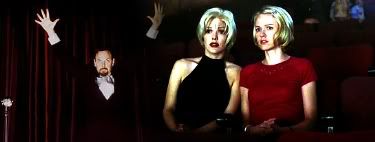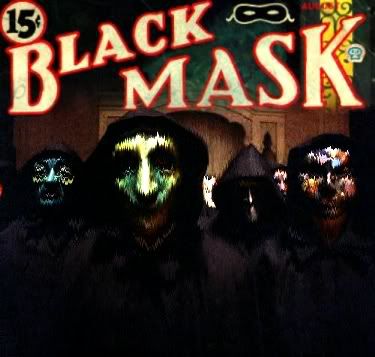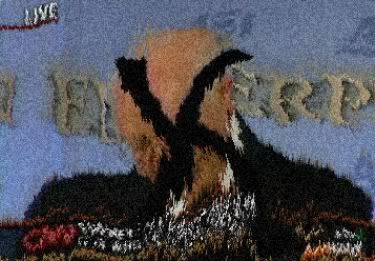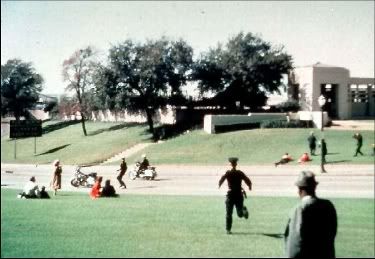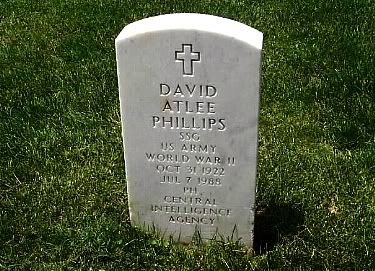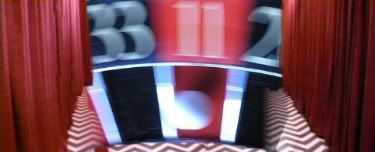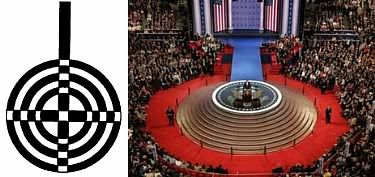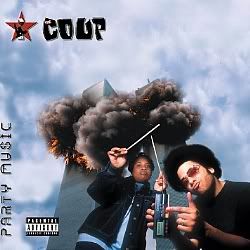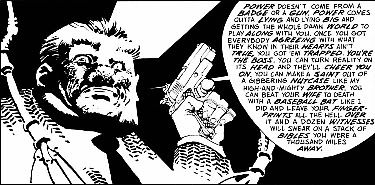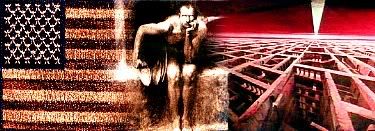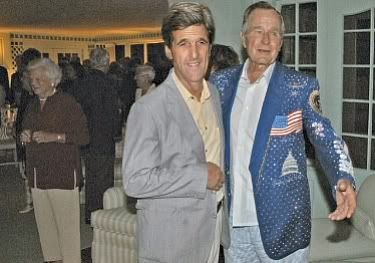Correspondence and sanctuary (Part Two)
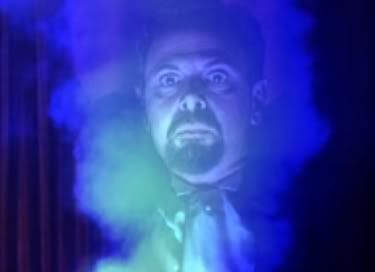
"Silencio." - Mulholland Drive
It's hard sometimes to justify what I do here, and for a number of reasons.
I worry about my writing becoming nothing but morbid entertainments, like evangelical tracts that decry the Devil and his ways and then indulge the reader's unadmitted fantasies with details of the dark worship. I worry that maybe I'm compounding distraction and a sense of futility. Most of all, I worry that I'm right. Even a little. And again, for a number of reasons.
I've begun logging unusual phone calls. Frequent untraceable silences, odd beeps, industrial noise and strange voices. Maybe, as most mothers might say, I just read too much. Maybe I simply have a lousy phone line. But I'm starting to keep a record nonetheless.
Our car was broken into the other night. Other than some change it seems that nothing was stolen. Not exactly high drama in the big city. It happened before, when the world was more or less recognizable. Still, for a moment I had that feeling in the pit of my stomach, and couldn't help but wonder.
I get that feeling sometimes looking at how IPs of frequent visitors to the blog resolve to defence agencies and installations, and such concerns as Mitre Corp, Booz Allen Hamilton, Dyncorp, NASA, Lockheed Martin, Los Alamos and Brown Brothers Harriman. But I can't know who's on the other end, or why. The military-industrial-financial complex is just that, and it's foolish to presume that everyone in its employ is in on it. Some may just be looking for a glimpse of a bigger picture drawn from an alternate map. Some may want something else. Hundreds of hits from the Pinkerton division devoted to government computer security suggests something else. Perhaps that they want me to know they're watching. And why on Earth would they want to do that?
Paranoia's the Black Lung disease of miners down the rabbit hole. Once you obsess that they're out to get you, they've got you. Often, I would think, without their even knowing it.
Perhaps that's what got Woody shot. There are lots of good minds out there broken by the evil of the world. And there's something about the Bush family that brings it out in people. The Web is littered with exquisite examples.
But of course, they are out to get us - aren't they? Certainly they mean to stop us from stopping them, and will use any means necessary to do so. But short of that, maybe not. They may even want us to do our thing, and stoke the paranoia, because that suits them just fine.
There's an aspect of the UFO phenomenon that I find very suggestive of this, though I don't know whether it's possible anymore, after the Will Smith movies, to have a serious discussion about "Men in Black." Still, I'd like to give it a shot.
The usual interpretation of these bizarre encounters is that of threat. Cryptic and dreadful warnings are spread to UFO witnesses to "keep quiet" about what they saw and what they know, even if they saw little and know even less. Yet the threats never appear to be carried out. As with the phantom clowns, social workers and census takers, the sense of menace is delivered, but that's the end of it.
John Keel's The Mothman Prophecies and Jacques Vallee's Confrontations record accounts of "Men in Black" visitations so strikingly similar, they perhaps provide keys to understanding the nature of the phenomenon.
Keel tells of a tall man with pointed features and "thyroid" eyes, wearing an ill-fitting and out of fashion black suit, sat in a booth at a New York City restaurant in the summer of 1967 and said he wanted something to eat, but could be no more specific than "food." The waitress brought a steak, which he stared at for a long while, then picked up his knife and fork and observed the other patrons. He did not know how to use the utensils. The waitress watched him fumble for a while, and then showed him how to cut the steak and spear it with his fork. She asked him where he was from. He answered, "Another world." Hardly the actions and words of someone whose mission is dissuading people from an interest in UFOs.
In May of the same year, a figure identifying himself as "Major Richard French" of the US Air Force entered the restaurant of a Mrs Ralph Butler in Owatonna, Minnesota. French had an olive complexion and pointed features, and dark hair that was much too long for an air force officer, Mrs Butler thought. He was dressed in civilian clothes that seemed brand new. Butler saw the soles of his shoes and they absolutely unscuffed. Otherwise, he appeared unexceptional until he complained about an upset stomach, and Butler brought him some Jello.
"Did you ever hear of anyone - especially an air force officer - trying to drink Jello?" Butler asked. "Well, that's what he did. He acted like he'd never seen any before. He picked up the bowl and tried to drink it. I had to show him how to eat it with a spoon."
One of Vallee's investigations in Confrontations takes him to Happy Camp, a small lumber town near Mt Shasta in Northern California. In the Fall of 1975 a rash of UFO sightings, entity encounters and abductions rattled the community, which already had a Fortean reputation for Sasquatch spotting and "local legends about the Puduwan, strange beings with paranormal powers." (And as in Roswell and Point Pleasant and Hopkinsville and similar towns across America, the Chamber of Commerce sees a buck to be made in the legacy of weirdness. The lead story of the latest edition of Happy Camp News is "Bigfoot Video Cameras Are Down.") In one bizarre incident, five disparate witnesses claim to have been led from a foggy canyon, in confusion, onto a craft by beings which spoke to them about the Bible. Their next conscious memory was, unaccountably, driving down the mountain singing an old Gospel chorus. Vallee writes that he finds it "interesting that the hymn they were singing was 'There is Power in the Blood of the Lamb.'"
Vallee continues:
The Happy Camp events encompass abductions, suffocating fog, large birds, small beings with welder helmets, chases by jets, poltergeists [and] gravity anomalies.... But it would not be complete without its own Man in Black episode.
Thus I was almost relieved to learn how, early in 1976, a stranger who had never been seen in town happened to stroll into Lois's Cafe. Helen and Pat [two contactees] were there, quietly having dinner at different tables.
All conversation stopped when the man came in. He ordered a steak dinner but proved unable to use a knife and fork, and eventually left without paying, a sure way to be remembered by the local people. Pat told me that he had pale skin and "oriental" eyes. He wore a bizarre sort of shirt and no coat, although it was the middle of winter. He smiled constantly at people in a strange, forced grimace. Among the peculiar things he did during his extraordinary dinner was a brave attempt to drink Jello out of his glass.
Keel's and Vallee's restaurant stories are separated by eight years and thousands of miles. If it were virtually anyone but Keel and Vallee telling them, I would presume them to be hoaxes or urban legend. But they conduct their own investigations on site, rigorously avoid leading witnesses, and are skeptics in the best and proper sense of the word.
Such incidents are typically described by observers of the phenomenon as "slip ups." Keel writes that "a few, like Richard French, almost pulled off their capers without drawing attention to themselves. But in nearly every case there was always some small error, some slip of dress or behavior."
Perhaps, instead, we ought to consider that there is a correlation between effect and intention. These aren't slip ups. These are displays. Rather than dissuade people from thinking and talking about UFOs, they encourage speculation and breed paranoia. Many witnesses hadn't thought much about their sightings, or told many people, until visited by odd figures who say "we know what you saw" and warn them not to speak of it. Instead of turning attention away from the phenomenon, these characters draw attention to it. Just like UFOs, which act as though they want to be seen rather than not, the "Men in Black" make spectacles of themselves. Why?
"Men in Black," when they appear to be men at all - some outstanding encounters describe comically robotic figures - are often said to have ruddy or olive complexions and "oriental" or "thyroid" eyes, speak in "sing-song" voices and walk in a halting manner as though out-of-sync with our reality and strangers to our time and space. Keel says they often claim to be representatives of the "Nation of the Third Eye."
This is one of those many times when I've believed I've had an original idea, only to find it's already on the table: perhaps what we call the "Men in Black" are entities manifesting themselves as representatives of Shamballa, the Great White Lodge of Sirius linked to Tibet and Eurasian mythology. (Also see this post, and these two threads, for recent studies of the significance of Shamballa and Eurasian mythology to modern apocalpytics such as Richard Heinberg.) I would suggest, though, the possibility that this appearance is assumed not because it reflects reality, but because these are tricksters adapting to the contours of belief of elite occultists, whose energies call them forth.
Perhaps this is why they often assume the guise of government agents, or are mistaken for such, because they are mimicking their occultic human complement. They also share an interest in inducing paranoia, even as they make a pretense at doing the opposite.
There are things of which we should be afraid, but we can be smart about it. Paranoia is fear bred in ignorance, which only serves the interest of the would-be rulers of the world. Paranoia is not knowing what we're up against. As weird as things get, if we can see it coming then we may in a position, and on our feet, in order to do something about it.
